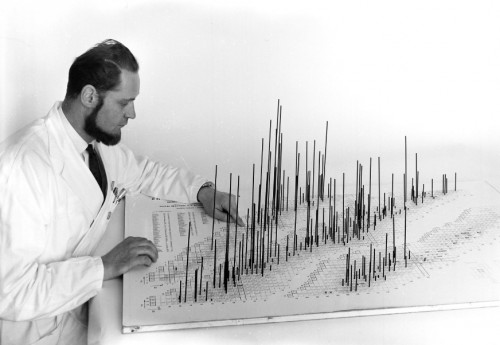Tag archives: biophysics
Scientists officially ground Spider-Man

Stick together: both ants and geckos have adhesive pads that let them scale vertical surfaces. (Courtesy: A Hackmann/D Labonte)
By Tushna Commissariat
Don’t tell the kids just yet, but becoming Spider-Man, even after being bitten by a radioactive spider, is looking less and less likely for us humans – we are just too big. The latest work, done by researchers at the University of Cambridge in the UK, has shown that gecko-sized is pretty much the largest you can be if you realistically want to scale up walls with adhesive pads. Any bigger, and most of your surface area would need to be covered in large sticky pads to pull off the gravity-defying walk. Indeed, the team estimates that roughly 40% of an average human being’s total body surface would need to be sticky – this means a whopping 80% of your front would be covered in adhesive pads.
The physics of Alzheimer’s disease

Jennifer Tang and Maikel Rheinstadter.
By Hamish Johnston at the CAP Congress in Edmonton, Alberta
One promising route to understanding the causes of Alzheimer’s disease (AD) – and hopefully finding a cure – is the study of how and why proteins in the brain sometimes form neurotoxic plaques. These plaques are disc-like structures that are about 50 µm in diameter and made from polypeptides. Their presence in the grey matter of the brain is strongly associated with AD and some other neurological conditions, but why they form and why they cause dementia are both not understood.
View all posts by this author | View this author's profile
A sight for blind eyes
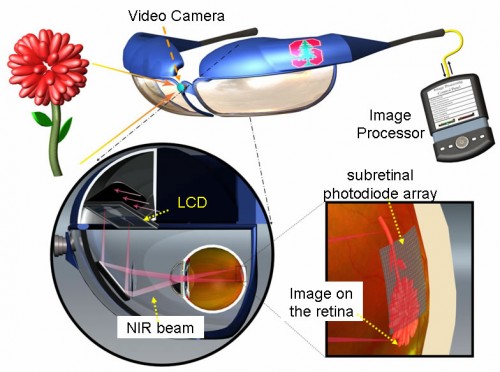
A schematic of the prosthetic vision system developed by Daniel Palanker. (Courtesy: Daniel Palanker)
By Margaret Harris at the AAAS meeting in San Jose
“Restoration of sight to the blind” is a brave claim, one with an almost Biblical ring to it. For Daniel Palanker, though, it is beginning to look as if it is an achievable goal. A medical physicist at the University of Stanford, Palanker has developed a prosthetic vision system that replaces damaged photoreceptors in the retina with an array of tiny photodiodes. When infrared images are projected onto this array, the photodiodes convert the light pulses into electrical signals, which are then picked up by the neurons behind the retina and transmitted to the brain. The result is an artificially induced visual response that, while not as good as normal vision, could nevertheless provide “highly functional restoration of sight” to people with conditions such as retinitis pigmentosa or age-related macular degeneration (AMD).
Photonics by the Bay
By Margaret Harris in San Francisco
The International Year of Light is a global celebration, but right now, it’s definitely got its heart in San Francisco. For the past five days, experts in optics, lasers and biomedical imaging have been converging on the “city by the bay” for the annual Photonics West conference, and I’ve joined them in order to learn more about the hot topics in optical science.
View all posts by this author | View this author's profile
Big data offers biomedical insights
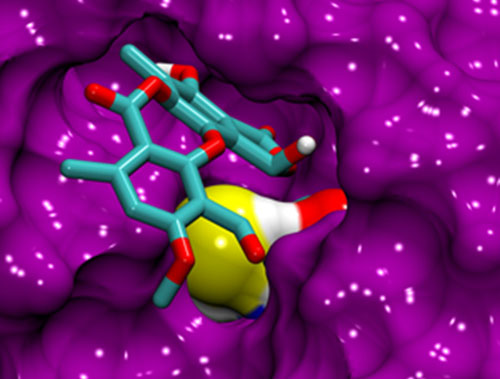
Suits you. This simulation of the p53 protein shows stictic acid fitted into the protein’s “reactivation pocket”. (Courtesy: Özlem Demir)
By Susan Curtis in Baltimore, US
At the 59th annual meeting of the Biophysical Society today, Rommie Amaro of the University of California, San Diego, highlighted the power of computational methods to speed up the discovery of new drugs to treat diseases as diverse as flu and cancer. Amaro focused on a recent project conducted while she was at the University of California, Irvine, to identify compounds that could play a vital role in future anti-cancer drugs by helping to reactive a molecule called p53 that is known to inhibit the formation of cancer cells.
View all posts by this author | View this author's profile
Physics meets biology in Baltimore
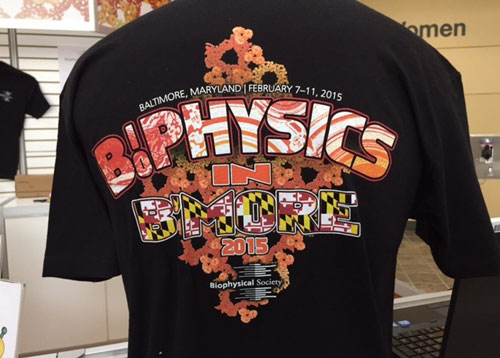
Biophysics in Baltimore: the T-shirt that does what it says on the tin.
By Susan Curtis in Baltimore, US
I’m in Baltimore this week for the 59th annual meeting of the Biophysical Society. The field of biophysics has grown rapidly in recent years as physics-based techniques have opened up new ways to study and understand biological processes, but with my limited knowledge of biology I was nervous that I would feel a little out of my depth.
The first talk of the “New and Notable” symposium helped to allay my fears. Michelle Wang is a physicist at Cornell University in the US who exploits optical techniques to trap and manipulate biomolecules. While established methods can only trap a single biomolecule at a time, Wang and her colleagues have pioneered the use of nanophotonic structures that can trap multiple biomolecules in a standing wave created within an optical waveguide.
“Our optical-trapping innovation reduces bench-top optics to a small device on a chip,” Wang told physicsworld.com when the team first reported their so-called nanophotonic standing-wave array trap last year. Since then, Wang and her colleagues have been working to integrate fluorescent markers with the nanophotonic trap to track the position of individual biomolecules, and have also been experimenting with optical waveguide materials other than silicon to improve performance and enable new applications.
View all posts by this author | View this author's profile
Poetry please, a protein-folding app for your phone, and a new home for the Institute of Physics

Artist’s impression of the new headquarters of the Institute of Physics.
By Hamish Johnston
You may not know it, but you could be a poet.
The European Space Agency (ESA) and the Hubble Space Telescope have just launched a contest to find the best “Ode to Hubble” as part of the celebrations for Hubble’s 25th birthday. Although described as an ode, the contest is actually looking for a short video tribute to Hubble that can include verse, song, prose as well as still and moving images. The piece can either be about the telescope or one of its many discoveries. There are two age categories, one for “generation Hubble” – those born after its launch – and one for over 25s. So look to the stars and get those creative juices flowing.
Strange goings on at CERN, string theory with cats, Isaac Asimov on generating new ideas and more
By Hamish Johnston
“The past is a foreign country: they do things differently there,” is probably the only famous sentence written by the English novelist L P Hartley. It also sums up nicely a collection of photographs of CERN in the 1960s and early 1970s showing among other things a jolly worker wearing a beret, scientists wearing white lab coats and ties, and a strange religious-like procession. There are also lots of photos of vintage kit, including one of those huge vacuum-valve-powered oscilloscopes (probably from Tektronix) that would be familiar to physicists of a certain age. My favourite photo is shown above. It was taken in 1965, when 3D data visualization was actually done in 3D! I believe that the collection was put together by CERN’s Alex Brown and you can enjoy looking at all 55 images in the collection here.
View all posts by this author | View this author's profile
Working at the interface of physics and biology
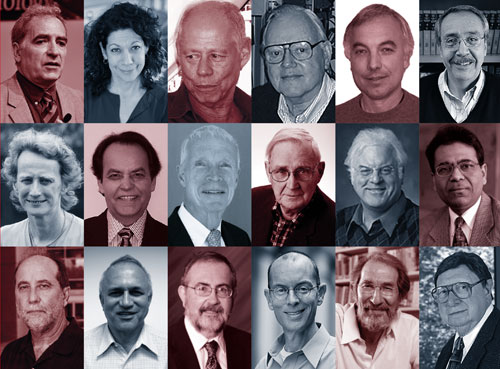
Face to face at the interface between physics and biology.
By Michael Bishop
In the 60 years since James Watson and Francis Crick brought physics and biology together to unveil the molecular structure of DNA, the boundary between the two disciplines has continued to become increasingly blurred.
In this post-genomic era, ever more principles from physics have been applied to living systems in an attempt to understand complexity at all levels.
Yet cultural differences still exist between physicists and biologists, as is made clear in a set of excellent perspectives in the journal Physical Biology, published by IOP Publishing, which also publishes Physics World.
In “Perspectives on working at the physics–biology interface”, a group of eminent scientists give their accounts of working at the interface of physics and biology, describing the opportunities that have presented themselves and outlining some of the problems that they continue to face when working across two fields with quite different traditions.
View all posts by this author | View this author's profile
A huge cycle in Sheffield, $30,000 for falsifying global warming and another physicist goes into advertising

Celebrating the Tour de France and Hans Krebs in Sheffield. (Courtesy: University of Sheffield)
By Hamish Johnston
Sports fans in the UK are spoiled for choice this weekend, with the Wimbledon finals in London and the kick-off of the Tour de France in Leeds. This is only the second time that the famous bicycle race has started in the UK and to celebrate, the University of Sheffield has created a huge image of a bicycle in a field near to the route. But as well as celebrating the passing cyclists, the image honours a very different cycle that makes the race and indeed much of life on Earth possible.
